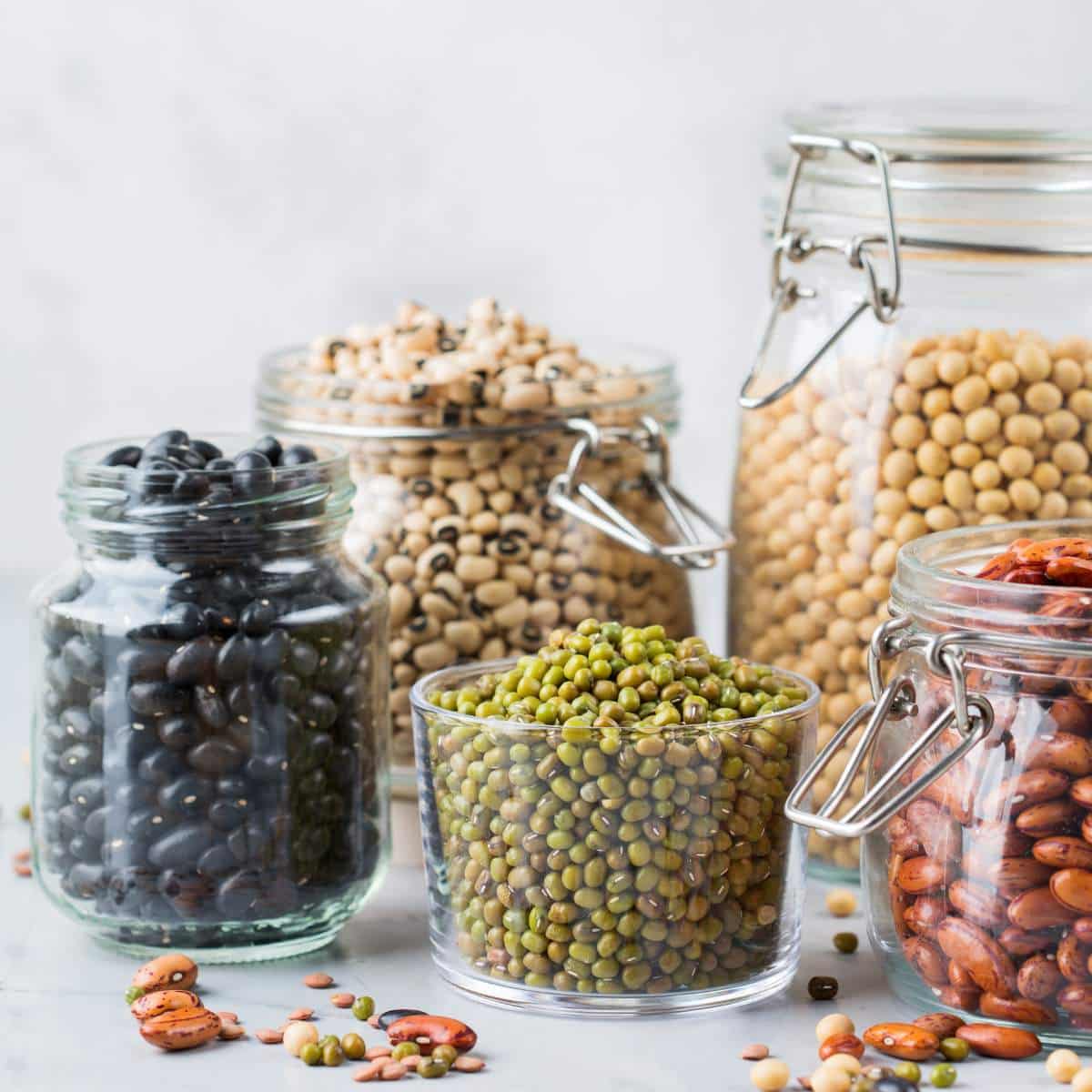If you’re looking for the BEST pomegranate molasses substitutes, this list is for you!
This post may contain affiliate links. Read my policy page for more information.
We’ve all been there—you’re in the middle of making a delicious recipe, and you realize you don’t have one of the key ingredients. Thankfully, these substitutes are accessible and easy to use, and I break down exactly how each one of them works.

Jump to:
What is pomegranate molasses?
Pomegranate molasses is a thick dark-red syrup that’s sweet, tart, and tangy. It has the consistency of honey and a strong and bold flavor.
It’s made by cooking down pomegranate juice, often with lemon juice and sugar, until the mixture is thick and concentrated.
What is it used for?
Pomegranate molasses is commonly used in Middle Eastern cuisine in salad dressings, glazes, marinates, and as a finishing touch on dishes.
The uses are truly endless and you can even add it to desserts. For example, adding a tablespoon of pomegranate molasses to your cake frosting can be a great way to add more flavor.
I love drizzling the thick syrup over sliced fruit or this summer blackberry salad and using it to marinate tempeh or tofu. It’s a perfect glaze to go along with vegan meatloaf or vegan steak.
How to make it
If you don’t have pomegranate molasses, your best bet would be to make it at home. This would be by far the best substitute, plus, making your own pomegranate molasses is very easy to do!

Here’s everything you’ll need:
- 4 cups of 100% pomegranate juice
- 1/2 cup granulated sugar
- 1/4 cup freshly squeezed lemon juice
To a saucepan or a heavy-bottomed pot, add all of the ingredients and stir. Cook over medium-low or low heat for 1 hour, string frequently.
The mixture should have a gentle simmer, but it shouldn’t boil vigorously.
After 45 minutes, check for doneness—it should have a thick consistency. Dip a spoon in the molasses. If it coats the back of it, then it’s ready. If not, continue boiling for 10-15 more minutes, checking every 5 minutes or so.
The final results should be thick, glossy, and caramelized, but not burnt.
Best pomegranate molasses substitutes
Today we will be exploring the most convenient and easy substitutes for pomegranate molasses. Some of them are surprisingly simple to make, with ingredients that are available in most kitchen pantries.
Others can be found in most grocery stores or ordered online.
In any case, it is guaranteed that you’ll walk away from this post with at least a couple of ideas.
Reduced pomegranate juice

Also known as pomegranate reduction, this is by far the best option to use in place of pomegranate molasses since both use the same reduction process.
It’s made by simmering fresh pomegranate juice over low heat until it thickens and has no other ingredients added.
Pomegranate juice is widely available in most grocery stores and supermarkets.
This is an excellent substitute and should be your first choice if the ingredients are available to you, as it is essentially homemade pomegranate molasses.
Cranberry juice concentrate

Cranberry juice concentrate is less sweet and more tart than pomegranate molasses, but it can still work as a substitute in some recipes.
Depending on the flavor profile, you may need to add a little sugar to balance out the tartness.
You can also make it at home easily! Just by simmering cranberry juice on low heat for 45 minutes to 1 hour, or until it thickens and coats the back of a spoon.
Let it cool completely before using it in recipes with a 1:1 substitution ratio.
Tamarind paste

Tamarind paste is made from the fruit of the tamarind tree and is a popular ingredient in Asian and Indian cuisines. It is commonly used in curries, stews, and desserts.
Compared to pomegranate molasses, tamarind paste has a more pronounced tart flavor, is not as sweet, and has a thicker consistency. This is why you have to use it alongside a liquid sweetener like honey or agave syrup.
For every 1 tablespoon of pomegranate molasses, use 1/2 tablespoon of tamarind paste mixed with 1/2 tablespoon of agave syrup.
This substitute works best for salad, soups, stews, and other dishes that are more forgiving. Since the paste’s texture can vary quite a bit from brand to brand, it is best to taste-test frequently and adjust as you go.
While it may not be as commonplace as pomegranate molasses—this substitute should still be readily available to you in any local Indian, Mexican, or Asian food store.
Grenadine syrup

Grenadine syrup is another product made from pomegranate seeds. It has a deep red color and is generally used as an ingredient in cocktails.
The name essentially means “pomegranate syrup” and it’s made with pomegranate juice, sugar, lemon, and red food coloring. It has a sweet flavor and is not as tangy as pomegranate molasses.
It works best as a substitute in drinks like cocktails or mocktails.
As a rule of thumb, for every 1 tablespoon of pomegranate molasses, use 1/2 tablespoon of grenadine syrup.
Balsamic vinegar and sugar

If you’re making a salad dressing and you need a pomegranate molasses substitute, this will work in a pinch.
Balsamic vinegar has a tangy, rich, and complex flavor, and the sugar adds just the right amount of sweetness.
For every 1 tablespoon of pomegranate molasses, whisk 1 tablespoon of balsamic vinegar with 1 teaspoon of granulated sugar until most of the sugar has dissolved.
This substitute cannot be used in desserts, drinks, or other recipes where the balsamic taste will overpower the rest of the ingredients.
Date syrup and lemon juice

Although not the first option that comes to mind, this is a very easy and convenient substitute if done correctly. By mixing equal parts date syrup and lemon juice you can create an ingredient that can be used in most recipes that require pomegranate molasses.
Keep in mind that date syrup is very sweet and that you will need to adjust the amount of lemon juice to balance out the taste depending on each recipe.
It stores well and should be used just as you would use pomegranate molasses.
Honey or maple syrup and lemon juice

The idea here is similar to using date syrup—you’ll need to mix honey or maple syrup with lemon or lime juice, which will add the same sweetness and acidity as you find in pomegranate molasses.
Mix equal amounts of sweetener and lemon juice and use in any recipe that calls for pomegranate molasses with a 1:1 substitution ratio.
It does not copy the full flavor of pomegranate molasses, but it does add sweetness and tanginess which are the two main qualities you should be looking for in a substitute.
Raspberry jam

This may not seem like an intuitive choice, but raspberry jam can provide the same fruity, sweet, and tangy flavor as pomegranate molasses.
For best results, choose a jam that is on the tangier side. The texture should be thick and not runny!
If the raspberry jam you’re using is on the thinner side, simmer it over low heat until some of the liquid evaporates.
If it’s very sweet, mix it with a squeeze of lemon juice.
In general, you can substitute 1 tablespoon of pomegranate molasses with 1 tablespoon of raspberry jam. However, the ratios may change depending on the jam you’re using.
Cassis syrup

Cassis syrup, also known as blackcurrant syrup, is a sweet and flavorful syrup made from blackcurrants, which are dark purple berries.
It can work as a 1:1 substitute in some recipes, but keep in mind that it will give your dish a subtle berry-like flavor.
This substitute works best in salads and salad dressings, drinks, marinades, and sauces.
Plum sauce

Plum sauce is a light-brown sweet and sour condiment made from stewing plums with sugar, apple cider vinegar, spices, and aromatics.
It has a salty, tangy, and fruity flavor, making it a good substitute for pomegranate molasses in savory recipes.
As a general rule, for every 1 tablespoon of pomegranate molasses, use 1/2 tablespoon of plum sauce. Keep in mind that it will alter the flavor of some dishes since it has extra spices added in.
Fresh pomegranate seeds

This is the substitute that will give you by far the most different results, but will still add a pomegranate flavor plus some crunch.
Pomegranate seeds work best sprinkled over salads and dips and as a finishing touch on dishes like mashed potatoes, roasted veggies, or meats.
It can’t be used in dressings, sauces, marinades, or anything where you need a liquid substitute, for that matter.
FAQs
Nowadays, this ingredient is widely available in most big grocery stores. You can find it in Walmart, Kroger, Costco, and Whole Foods, or you can order it online on Amazon.
You can also look for a store that specializes in international foods near you. They’re most likely to carry pomegranate molasses since they often have a wide range of ethnic ingredients.
No, they’re two different things. Pomegranate molasses is a condiment and cannot be used in baking like regular molasses.
As we’ve already discussed, it’s made by cooking down pomegranate juice until the liquid evaporates and the mixture thickens.
Regular molasses, on the other hand, is a byproduct of the sugar-making process and it comes from sugar beets or sugar cane.
Yes! You’ll need to reduce the juice first by simmering it on low heat for 45 minutes to 1 hour.
However, if you are using pomegranate juice on its own without any alterations, it will not work that well as a substitute.
It should always be stored in the fridge, where it can last for up to 6 months. You can freeze it in a mason jar or a freezer-safe container, where it can last for 1 year.
Summary
In summary, there is no shortage of substitutes for pomegranate molasses you can use or make at home yourself.
The closest substitute by far is reduced pomegranate juice, as it keeps many of the same qualities, deep flavor, and even color.
In contrast, the most different substitute available to you would be fresh pomegranate seeds. This is because they add a very different texture to your recipes.
Whichever substitute you choose to use, always consider that different recipes would benefit in different ways from each one of these ingredients. Some may add a more fruitful taste, while others may be more sweet than tart.
At the end of the day, it depends on what best suits your recipe and what results you’re trying to achieve.
Learn more about different substitutes
- 10+ Best Coconut Aminos Substitutes
- Best Chickpea Flour Substitutes
- The Best Nutritional Yeast Substitutes
- The Best Coconut Sugar Substitutes
- Best Coconut Vinegar Substitutes
- Substitutes for Honey That Work Best
- Best Vegan Egg Substitutes for Baking and Cooking
Want to Save This Recipe?
Enter your email below and we’ll send it straight to your inbox! Plus, get weekly free recipes!
By submitting this form, you consent to receive emails from Health My Lifestyle.

Best Pomegranate Molasses Substitute
Ingredients
- 4 cups 100% pomegranate juice
- ½ cup granulated sugar
- ¼ cup freshly squeezed lemon juice
Instructions
- To a saucepan or a heavy-bottomed pot, add all of the ingredients and stir. Cook over medium-low or low heat for 1 hour, string frequently.4 cups 100% pomegranate juice, ½ cup granulated sugar, ¼ cup freshly squeezed lemon juice
- The mixture should have a gentle simmer, but it shouldn’t boil vigorously.
- After 45 minutes, check for doneness. Dip a spoon in the molasses. If it coats the back of it, then it's ready. If not, continue boiling for 10-15 more minutes, checking every 5 minutes or so.
- The final results should be thick, glossy, and caramelized, but not burnt, syrup.






